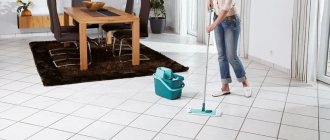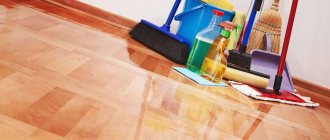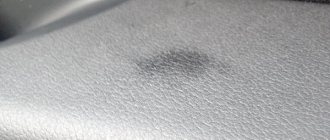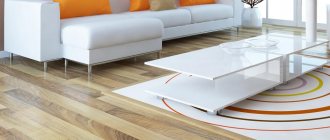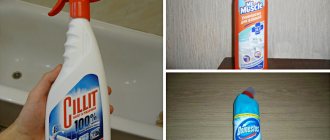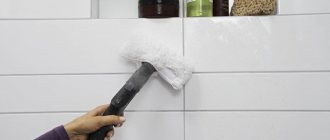Floor tiles are available in specialized stores in a variety of designs and color styles (by the way, porcelain stoneware and metlakh tiles are very popular today). It provides any room with a different level of aesthetic subtlety.
Expert opinion
Evgenia Taran
In addition to aesthetic benefits, floor tiles are also more durable than carpet, linoleum, or wood and are easier to clean. Dirt and debris that are deeply absorbed into the carpet fibers can be washed out of tile flooring relatively easily. Of course, this requires suitable tools and means.
Let's figure out how to clean the tiles on the floor from stubborn dirt.
Causes of stains on the floor
The main problem with floor coverings made of tiles is the appearance of stains after cleaning in the kitchen or bathroom. They appear for the following reasons:
- The tiled floor was heavily stained with grease that was not removed before mopping.
- Hard water was used during the cleaning process.
- There was a lot of detergent dissolved in the water.
- The rag used to wash the floor was not wrung out well, and it quickly became dirty.
- During cleaning, the water in the bucket practically did not change or changed very rarely.
Special cleaners for tiles
Chemicals such as Lysol are ideal for cleaning and disinfecting floor tiles. These cleaning products are specially designed to combat floor contamination and disinfect it. After using them, it is recommended to wipe the floor with clean water.
"Sanytol"
Removing grease and other contaminants (including in the kitchen) using Sanitol:
- Spray the substance onto the contaminated area.
- Leave the resulting foam to act for 10–15 minutes.
- Wipe dry with a cloth.
- Repeat as needed, depending on how stubborn the dirt is.
How to wash properly
Proper cleaning of floors is not a complicated process. It is enough to follow a simple algorithm of actions, and the tiles will shine with cleanliness, delighting you and your loved ones. The procedure is as follows:
- First, the surface is processed dry. A regular broom or vacuum cleaner will do for this.
- Next comes wet cleaning using detergents.
- Adding shine to tiles.
Note! After each stage, conduct a quick inspection for untreated areas, so that later you do not have to redo the whole job again.
Using special detergents
Tiles are most often washed using special detergents, the choice of which should be approached wisely. Most of them have a similar cleaning effect, but there are some products that differ from others for the better. Below are the brands that are in high demand among customers.
Silit
A high-quality detergent for kitchens and bathrooms, with high cleaning properties at a budget price. It helps not only to get rid of old stains, but also to destroy pathogenic bacteria, disinfecting the surface being treated.
Selena
If the tiles in the kitchen are stained with grease, and there is Selena stove cleaner on the shelf, use it for a comprehensive cleaning. This way there will be no greasy stains left on the surface, and the kitchen will shine like new. To wash the tiles, you need to:
- dilute the detergent in plenty of water;
- treat contaminated areas with it;
- wait 5-7 minutes;
- Wipe off greasy deposits with a clean cloth.
See also
Remedies and rules for quickly washing a multicooker at home
Amway
If you don’t like to skimp on cleaning your home by purchasing the most effective cleaning products, buy Amway products. With its help, not a trace of dirt will remain, although you will have to fork out quite a bit of money for this.
Mister proper
A popular product among housewives, in great demand thanks to:
- reasonable price;
- high quality of contaminant cleaning;
- versatility;
- no streaks after cleaning.
It can be purchased at any nearby store, in the household chemicals section.
Hedgehog
A budget-friendly dirt remover, the main advantages of which include:
- extremely low price;
- decent efficiency;
- fast cleaning speed from difficult stains.
Due to the low cost of the product, rather toxic components are used for its production, which is noted as the main disadvantage of the product.
Note! When working with any chemical, even if it is not toxic according to the manufacturer, do not forget to use personal protective equipment.
Sanitol
A universal kitchen cleaner that removes dirt from surfaces such as:
- glass;
- ceramics;
- metal.
Thanks to the convenient packaging and spray bottle, the substance is applied economically, without wasting time on preparation. Does not have a strong, pronounced odor. The only drawback is the price, which is significantly higher than average.
Milit
Concentrated kitchen cleaner, sold in convenient spray packaging. It copes equally well with dirt on all work surfaces that can be found in the kitchen. Economical consumption and low price will significantly save your home budget.
Traditional methods
Not all housewives trust special detergents, which often contain toxic components. And the home budget cannot always support such a purchase. Folk remedies come to the rescue, they are slightly less effective and much more environmentally friendly. We recommend that you pay attention to the following recipes.
Ammonia
An easy-to-implement recipe for removing dirt from tiles, because almost every family has a bottle of ammonia. Cooking algorithm:
- take 2 liters of water;
- dilute 1 spoon of ammonia in them;
- pour the mixture into a spray bottle;
- we treat contaminated areas;
- wait 5 minutes;
- wipe with a dry, clean cloth.
Vinegar
Another frequent guest in any kitchen, which makes a wonderful cleaning product. The method is implemented as follows:
- mix 1 liter of water and 90 milliliters of table vinegar;
- pour the solution into a spray bottle;
- treat the stain;
- wash off the substance with plenty of water;
- wipe dry.
Do not use vinegar essence, it is too concentrated and not suitable for our purposes. We take only a 6% solution.
See also
Ways to properly and quickly clean white leather at home
Lemon acid
An alternative to vinegar if you can't stand its strong, acrid smell, or if you don't have any in your kitchen. Citric acid can be diluted in water, but it is better to sprinkle it little by little on a damp sponge and rub it into the source of contamination.
Citric acid and vinegar not only remove dirt from the surface of the tile, but also disinfect it, killing mold and other harmful organisms.
Chalk
Owners of glossy tiles recommend treating their surface with regular chalk. To do this you need:
- dilute chalk with water to a mushy consistency;
- gently rub over the surface of the tile;
- remove excess substance along with dirt.
To add shine, you can rub the tiles with paper.
Chlorine
For those who are not afraid of the strong smell of chlorine, there is an excellent, effective recipe based on it:
- We dilute chlorine in water based on the proportions of 1 liter of water to 1 spoon of chlorine.
- We treat the tiles with liquid. It is advisable to use a spray bottle for these purposes.
- We wait 5-10 minutes.
- Wipe with a clean cloth.
A chlorine solution copes with any stains, even the most stubborn ones. While working, do not forget to protect yourself by wearing rubber gloves.
Fresh lemon juice
If you don’t have citric acid at home, don’t worry. Lemon juice comes to the rescue. It has a similar principle of action, but is gentle on the skin of the hands and has a mild, natural citrus scent. Housewives who care about the condition of their skin will appreciate this method of treating tiles.
Steam cleaner
A simple and convenient household appliance, ideal for cleaning tiles in the kitchen or bathroom. Thanks to the high temperature of the steam produced by the equipment, dirt quickly lags behind the working surface, leaving not a trace on it. It is enough to follow the instructions from the manufacturer, and there will be no problems with cleaning.
Melamine sponge
Science does not stand still; today housewives have access to a melamine sponge that can easily remove dirt from such surfaces as:
- glass;
- parquet;
- tile;
- metal.
To get started, you just need to wet the surface of the sponge and start treating the required area of the floor or walls with it. It is especially effective to use a melamine sponge in places where chemicals or excess moisture are undesirable.
The most effective folk methods
Ceramic tiles are popular due to their beauty, durability, and ease of maintenance. There are many ways to clean tiles, but many detergents contain harsh chemicals that are unfriendly to this surface. Their use can not only lead to serious health problems, but also cause severe skin irritation. In addition, most of these products are relatively expensive. The use of traditional methods for cleaning ceramic tiles is not only environmentally friendly, but also does not affect the budget.
Lemon acid
A solution prepared from 1 liter of water and 3 tbsp will help to refresh old tiles, remove rust stains from white or colored coatings, and wash away stubborn dirt. l. citric acid. Soak a sponge in the solution and clean the floor. Use a brush to clean the grout.
Important! The citric acid solution may cause skin irritation, so wear gloves before using it.
Vinegar
If you have young children, you are more likely to avoid chemicals. This is correct, because they are harmful to a child crawling on the floor. But there is an alternative in the form of non-chemical detergents. One of them is vinegar. To prepare a cleaning solution, mix vinegar with water (1:1). Use the solution in the same way as store-bought cleaning fluid.
How to get rid of stubborn dirt
A solution of vinegar and water, diluted in a ratio of 50 to 50, helps against dirt embedded in the tiles. This product helps to remove old stains from:
- rust;
- fat
See also
30 ways to clean a frying pan from carbon deposits at home
Use a regular soft cloth as a wipe. Sponges are not as effective, plus they can damage the surface of the ceramic, leaving abrasions on it.
How to clean floor ceramics
You can use a broom and dustpan to collect large debris. After this, use special products that will help achieve ideal floor cleanliness.
Some dirt cannot be removed with a broom. For example, a spilled liquid. Then a mop and a bucket of water will be your assistants. A sponge cloth is great for cleaning the surface. We described these cleaning actions in detail in the article on sanitary and epidemiological cleaning requirements.
Getting rid of difficult cases
Complex types of tile contamination that require a special approach include:
- fat;
- mold;
- grout for seams;
- traces of brilliant green;
- traces of polyurethane foam.
To clean them, you need to know certain nuances, which we will look at below.
Mold
To prepare an effective solution that removes mold stains without leaving a trace, you will need to mix:
- water – 7 glasses;
- ammonia - a third of a glass;
- vinegar - a quarter glass;
- soda - half a glass.
Mix the solution thoroughly and pour it into a spray bottle. Next, we treat the area affected by mold, and then wipe it with a damp cloth.
Fat
Baking soda mixed with vinegar will help get rid of fat. Mix them until they form a paste, then apply the resulting substance to the stain. It is necessary to wait some time for the product to penetrate into the structure of the contamination and begin to destroy it from the inside.
Once 5-10 minutes have passed after application, wipe off dirt and detergent with a damp rag.
Grout
To remove grout marks, you will need to buy a special detergent designed specifically for this purpose. You shouldn’t delay your purchase, because the longer you wait, the more the substance eats into the surface of the ceramic.
Polyurethane foam
Removed from contaminated surfaces using:
- mechanical actions that must be performed carefully, without fanaticism;
- using a special liquid.
Zelenka
If brilliant green gets on the tiles, ammonia will help remove stains. If it fails to remove the stain, you will have to buy special chemicals.
Cleaning tile joints
How to clean the grout between tiles?
Not only the surface of the tiles needs regular hygiene, but also the joints between the tiles - these places are especially vulnerable to dust, soap scum, dirt and mold. How to remove dirt between tiles? Here are proven methods:
- The easiest way to bring the seams into proper condition is to treat them with baking soda. To do this, you will need an old toothbrush or brush: moisten and sprinkle the bristles generously, and diligently rub the resulting pulp into the joints. There is no need to rush into rinsing - leave the paste for at least a quarter of an hour. For preventive purposes, it is advisable to repeat this procedure weekly.
- At the early stage of fungal infection (when the seams acquire black dots), vinegar should be actively added to cleaning, and in concentrated form. This treatment will prevent the spread of mold and return the tile to its former “well-groomed” appearance.
Attention: on tile joints covered with a layer of sealant, use vinegar with extreme caution. If you get too carried away with such disinfection, the grout may very soon need to be replaced.
- If the light-colored joints have become noticeably darkened, they can be refreshed with household bleach (it is better to take an oxygen-based product - for example, Vanish) or a powerful cleaner like Domestos. The principle of operation is the same as when working with soda; the composition should be washed off several times in a row.
- Among folk remedies, hydrogen peroxide has proven itself brilliantly: it can both whiten and eliminate mold. All you need to do is wet a sponge or piece of cotton wool and then slowly walk along the joints. Peroxide works even more productively when paired with baking soda or dish gel; they are simply mixed and left on the seams for about a couple of hours. Finally, the joints are wiped with a brush and washed with clean water.
- Copper sulfate can also stop the “adventures” of the fungus. Measure 30 grams of granules per liter of water, and pour the finished solution into a spray bottle. Before using this antibacterial spray, moldy areas should be cleaned with a stiff brush and soapy water.
- It removes mold between tiles very well. The powder is diluted in clean water at the rate of 200 grams per 2.5 liters. The product does not require rinsing - lingering on the surface, it forms a lasting protective barrier.
- Some essential oils, in particular tea tree and grapefruit, can make impressive progress in the fight against fungus. Natural antiseptics are combined with alcohol and water (2 teaspoons per half glass, respectively). You can distribute the liquid with a spray bottle or sponge.
- In advanced cases, when the cladding has practically nothing to lose, rough mechanical grinding is possible - with sandpaper, a nail, a special machine or a grinder. After cleaning, the joints must be disinfected and primed. Later, using a rubber spatula, a new layer of grout is applied.
To protect the seams of ceramic tiles, special products are produced - sealants. They clog the pores of the grout, preventing dust and dirt particles from getting stuck. Washing treated joints is not accompanied by any difficulties; the main rule is not to get carried away with aggressive acidic cleaners.
Tip: When applying transparent sealant, you need to act extremely carefully. To prevent the tenacious compound from getting onto the surface of the tiles, it is recommended to cover their contours with tape, and, of course, it is best to entrust this painstaking task to an experienced specialist.
If you are pursuing a purely cosmetic goal in updating the seams, it makes sense to think about buying a special plumbing pencil. A waterproof grout marker masterfully fills joints with snow-white dye, and thanks to its convenient design, even an inexperienced craftsman can handle the application of “white” (usually the kit includes several nozzles of different thicknesses). The composition of the dye has an antibacterial effect, which greatly facilitates the removal of mold. It is worth noting that the miracle felt-tip pen comes not only in white - it is possible to choose a shade to match any color of the tile.
Rules of care
To avoid having to resort to drastic measures when cleaning floor tiles, adhere to the following care rules:
- Do not rub the stain with a hard brush or products that contain abrasives. They leave microscopic damage on the surface of the material, reducing the presentation and shelf life of the product.
- Don't put off starting cleaning for too long. Remember that the longer you wait, the more the stain eats into the tile.
Primer
Now let's look at how you can clean ceramic tiles from primer after repair. White stains often remain on floor tiles, since the installation of wall cladding is carried out after it has been laid. It is advisable to spread a protective film on the floor, but this does not always provide a 100% guarantee of protection against stains.
If the primer gets on the tile, it is advisable to wash it off with clean water as quickly as possible. When the substance dries it will harden and it will be much more difficult to wash it off. For this purpose, you can use the following tools:
- special solvent-based remover;
- acetone;
- polyurethane foam;
- fresh primer.
As soon as the stain softens, you can try to clean it off. You can also use a special scraper with a sharp blade, which can be used to remove drops of frozen paint from glass surfaces.
The primer is best washed off before it hardens with clean water or solvent
Removing black stripes from the floor is easy!
If there are black stripes left on the floor, be it laminate, linoleum or parquet, from rubber shoes, you can easily remove them by rubbing, believe it or not, with a tennis ball. Yes, yes, just a ball; if you remember, it has such a fleecy surface. This ball is generally a useful thing to have around the house; it also makes washing down jackets and blankets easier.
Very thin strips can simply be wiped with a dry cloth, and especially greasy strips that could not be destroyed by previous methods can be carefully rubbed with a paste of damp soda.
After renovation
Dealing with contamination after repair is much more difficult, especially when its surface is rough.
Step-by-step cleaning of flooring after renovation:
1) First of all, it is necessary to remove traces of glue. To do this, you can use vinegar diluted with water. Apply with a soft brush. Do not use metal devices!
2) Hardened putty can be removed using a scraper.
3) You can remove traces of tape with nail polish remover.
4) A soap solution will work well with the primer. Dried marks can also be soaked and removed with a sponge.
5) You can remove cement using salt. To do this, you need to sprinkle salt on the surface and add a little water. After the product has taken effect, remove with a brush.
6) Many hardened solutions can be removed using a gel-like toilet cleaner.
7) In some cases, it may take several days for the stains to completely soak out. After this, the tiles are washed with detergent.
 Gasoline removes paint well. Then the floor is washed with soapy water.
Gasoline removes paint well. Then the floor is washed with soapy water.
